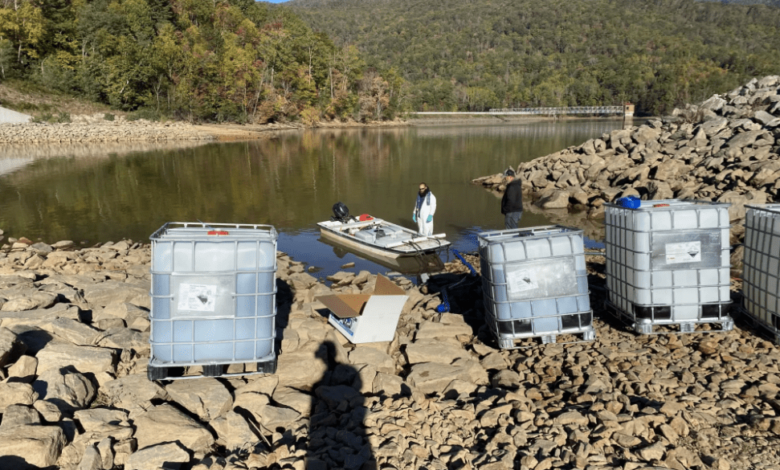With Asheville water nearly restored, workers focus on stabilizing leaks, breaks in system


By Andrew R. Jones
Asheville Water Resources has restored running water to almost all of the city, but three weeks after Tropical Storm Helene, workers are still playing catch up with breaking or difficult-to-access areas, as well as water purity.
“We’ve gotten service to 90-ish percent of our system, probably pushing 95 by now,” Asheville Water Resources spokesperson Clay Chandler said at the Oct. 18 Buncombe County Helene recovery briefing. “We understand that there are still pockets that don’t have service. We understand that that’s frustrating for the residents. It’s frustrating for us, too.”
Those areas include the Bee Tree area, which has a line needing backfilling and stabilization before it can be pressurized; Reynold’s Mountain, which has a higher elevation and is therefore more difficult to restore; and parts of Candler.
“There’s going to be pockets that get water service after others, and that’s due to a couple of factors,” Chandler said. “The primary factor being elevation. I don’t think that applies to Candler, but, you know, we found some leaks and some breaks that we would find only once pipes were pressurized.”
Officials have predicted these breaks since they started fixing the system and may see more in the coming days.
“We’re working as quickly as we can to get those fixed,” Chandler said. “There’s a leak somewhere (in the Bee Tree area) that our staff is trying to find.”

There’s no exact timetable for restoration at Bee Tree, where 40 homes are waiting for water. There’s better news on Eastmoor Road, east of Asheville, where 75 homes are waiting for water.
Water was expected to be there by Friday night, Chandler said.
As the city tries to stamp out smaller issues across the system, bigger ones regarding water purity remain.
A boil water notice remains in effect for everyone on the system. Getting rid of particles in the water after Helene whipped it up into a chocolate milk-like soup of sediments is key to removing the notice and making the water safe to drink again.
Up at the North Fork Reservoir, the city is treating the water with a mix of aluminum sulfate and caustic soda. Workers have used a boat to dump tote bags full of chemicals into the reservoir in an effort to purify the water.
Aluminum sulfate is a “salt-ish” mineral the department uses to regularly treat the reservoir, as it makes clay particles coagulate and sink, leading to clearer water for filtering and treatment.
The water department also will treat the water with additional caustic soda – another chemical it regularly uses – which regulates the water’s pH level so the aluminum sulfate can work most effectively.
More rounds of treatment are on the way, and Chandler said he didn’t know how many would be needed.
He said that the city is treating the lake with 10 parts aluminum sulfate and caustic soda per million.
“We generally treat between three and four parts per million,” Chandler said. “Now, I know that sounds like an astonishing increase, but for a little context, the reservoir in Mississippi, where I moved here from, routinely is treated with this same process at 15 to 20 parts per million. Some drinking water reservoirs that are especially turbid can be treated between 50 and 60 parts per million.”
The city plans to install curtains to help sift the water to remove particulates.
Asked about the timeline for installing these, Chandler said, “Unknown.”
A boil water notice, according to the city’s official guidance, means any water intended for consumption — drinking, cooking, brushing teeth — should be boiled for at least one minute beforehand. Water out of the tap is safe for handwashing (unless hands are being cleaned for food preparation), showering (be careful not to swallow water while showering) and laundry. The water is safe for washing dishes, as long as a dishwasher’s temperature reaches a minimum of 170 degrees, which typically happens when the “sanitize” setting is activated.
“Our plan now is to lift the boil water notice when the entire system has potable water,” Chandler said.
[Correction: An earlier version of this story misstated the location of Eastmoor Road. It is east of Asheville.]
The post With Asheville water nearly restored, workers focus on stabilizing leaks, breaks in system appeared first on North Carolina Health News.